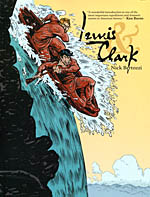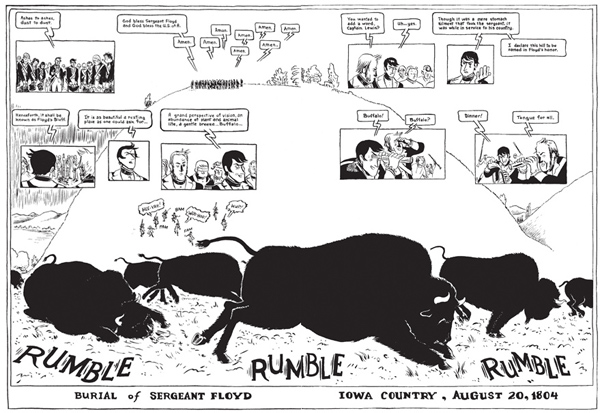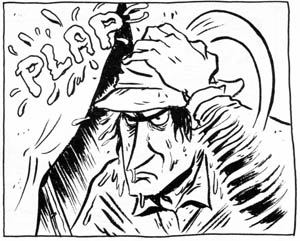 By Nick Bertozzi
By Nick Bertozzi
144 pages, black and white
Published by First Second Books
Lewis and Clark’s expedition to the West Coast is one of those things that most Americans know about in terms of the absolute basics (they were sent by President Thomas Jefferson to find a water route to the West Coast, one of their guides was the Native American Sacagawea), but almost none of the details. I hate to admit that I fall into that category, so between learning more about this important expedition and also getting a new Nick Bertozzi graphic novel, Lewis & Clark looked immensely promising. What we got? In some respect it feels almost like Lewis & Clark: The Cliff Notes Edition, but the more I think about it, the more I believe that’s a good thing.
Lewis & Clark focuses primarily on Meriwether Lewis, the temperamental co-leader of the expedition through (and beyond) the newly acquired territory from the Louisiana Purchase. It’s a smart decision on Bertozzi’s part; William Clark, according to history, was a fairly level-headed and calm person, while Lewis was prone to self-doubt, depression, and emotional outbursts. When you consider that Clark isn’t even the third most interesting character in Lewis & Clark, it seals the deal. Lewis himself is an entertaining person to read about; his determination is clearly one of his strongest points, and it shows why even though he had many issues and problems, President Jefferson would still choose him to lead the group to the West Coast. Bertozzi gives a great deal of balance to Lewis, showing both sides to his character and letting the reader ultimately make a final decision on him as a person.

As for the plotting itself, Bertozzi is in a tough spot with trying to condense a three year expedition into just 144 pages. The end result is, as mentioned before, a highly truncated story, but one that still gives enough to let the reader have an overall feel for the journey. So we get the highlights as they move across the country, shown to us in two-to-four page episodes. For the most part, it works; we get an idea of how things are shaping up, then slide along to the next encounter or obstacle. Occasionally, though, once the book moves ahead in time it’s a little frustrating; you want to see more from that particular moment. It’s Sacagawea’s life that I think ultimately becomes the most intriguing in many ways; I finished Lewis & Clark interested in this woman and wishing there had been room to stick with her a bit longer and let us get a stronger grasp of her as a person.
 Bertozzi has fun with the art, sometimes moving horizontally across massive two-page spreads, other times going for a more standard approach where each page is its own unit. It’s his experimenting with layout that immediately grabbed my attention; he uses the placement of panels to try and help mimic a lot of their journey. Rough river rides have the panels zig-zag across the page, and a glimpse of a buffalo stampede in Iowa gives the creatures all the space they need to run across the page while the people are almost like specs in comparison to the bounty of land around them. Bertozzi’s focus on his characters works well too; I love the annoyed expressions on Lewis’s face in particular, but in general when his characters show joy or sadness, it’s reflected beautifully on their faces.
Bertozzi has fun with the art, sometimes moving horizontally across massive two-page spreads, other times going for a more standard approach where each page is its own unit. It’s his experimenting with layout that immediately grabbed my attention; he uses the placement of panels to try and help mimic a lot of their journey. Rough river rides have the panels zig-zag across the page, and a glimpse of a buffalo stampede in Iowa gives the creatures all the space they need to run across the page while the people are almost like specs in comparison to the bounty of land around them. Bertozzi’s focus on his characters works well too; I love the annoyed expressions on Lewis’s face in particular, but in general when his characters show joy or sadness, it’s reflected beautifully on their faces.
If nothing else, Lewis & Clark is a great incentive to read more about this famed expedition. I’m definitely going to add a book or two about them and Sacagawea onto my reading list, because Bertozzi has given me just enough to whet my appetite for more. And ultimately, I think that’s exactly what the book should have done. There’s no way Bertozzi could have told every single detail of their three years away, so this served up just the right amount. Mission accomplished.
Purchase Links: Amazon.com | Powell’s Books
